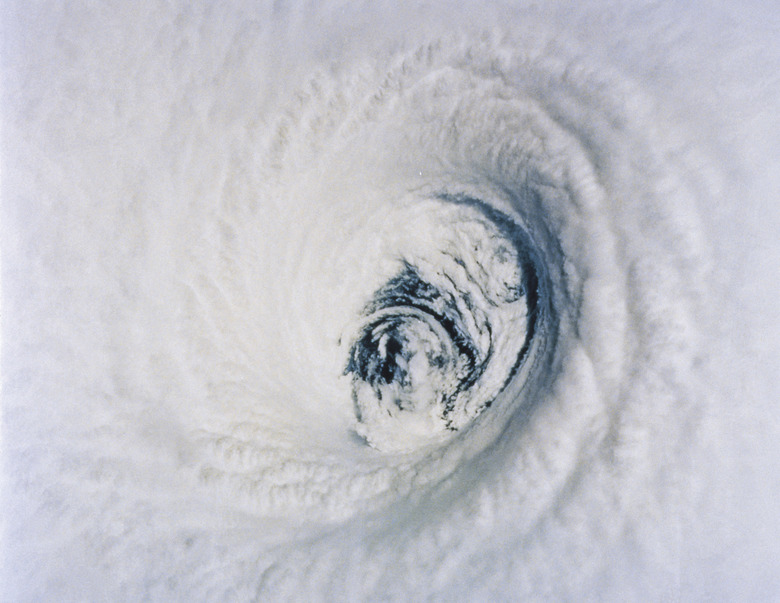What Causes The Clouds Of A Hurricane To Spiral?
The satellite portrait of a hurricane is unmistakable: a mighty vortex of towering clouds, with a clear "eye" as the hub. These gargantuan, savage types of storms on Earth start out at low latitudes, shoved along by trade winds. Most such tropical types of cyclones form in distinct breeding grounds in the western and eastern North Pacific, the western Atlantic, the Indian Ocean and the western South Pacific.
Along with the standard "hurricane" – as they're referred to in North and Central America – they are also referred to as typhoons, baguios and cyclones in various regions of the world. The ferocious spiral of their winds, which can rage beyond 240 kilometers per hour (150 mph), derives from a confluence of forces.
Pressure Gradient Force
Pressure Gradient Force
Wind is the movement of air from areas of higher to lower atmospheric pressure. A low-pressure cell is called a cyclone, not to be confused with the regional term for hurricanes in the Indian Ocean. The opposite situation is the anticyclone, a high-pressure cell. Wind flows outward along a pressure gradient from an anticyclone, inward in a cyclone. A hurricane is one of type of cyclone with a particularly severe pressure gradient, intensified by warm ocean waters and the latent energy of condensation.
The Coriolis Effect
The Coriolis Effect
If the planet were stationary, winds would rush into areas of low pressure head-on – that is, perpendicular to the lines of common pressure called isobars. However, the Earth rotates on its axis and that planetary spin diverts blowing air off of what would otherwise be straight-line paths. This rotational impact is called the Coriolis effect.
In the Northern Hemisphere, the winds are deflected to the right; in the Southern Hemisphere, they're deflected to the left. Upper winds thus spiral around a low, roughly parallel to isobars – this results in counterclockwise rotation in the Northern Hemisphere, and clockwise rotation in the Southern Hemisphere.
The Coriolis effect is virtually nonexistent along the equator, and so hurricanes, despite their tropical habitat, don't form within a few degrees of that global midriff, nor do they cross it: Low-pressure cells there are directly "filled" by incoming air, without the cyclonic whirling that helps birth a hurricane.
Impact of Friction on Hurricanes
Impact of Friction on Hurricanes
Closer to the Earth's surface, however, another force acts to modify air movement: friction. Lower winds drag against land or water and thus spiral more tightly around the low – an effect usually seen within an altitude of 5,000 feet. The influence can be conceptualized in terms of angles. If the only force determining air movement were the pressure gradient, wind would flow at 90 degrees to isobars; under the influence of the Coriolis effect alone, it would flow at zero degrees. Friction warps the angle of wind over isobars to somewhere between zero degrees and 90 degrees.
Hurricane Structure
Hurricane Structure
The fiercest winds of a hurricane are generally those spiraling tightly and swiftly upward around the eye. These are the gales sucked in down the pressure gradient and hastened enormously by the condensing isobars near the center of the low. As they strengthen, the winds boost evaporation of surface waters; as they surge upwards, the water vapor condenses and releases massive amounts of latent heat energy.
This energy fuels the hurricane and builds the towering thunderheads of the eyewall, into which the cyclone's radiating rainbands corkscrew, giving the hurricane its characteristic spinning shape. The violent eyewall mounts tens of thousands of feet into the sky while the air within the eye of the hurricane slowly sinks. This sinking air discourages cloud formation and keeps conditions there strangely calm. The air spun upward in the rainbands and eyewall then drifts outward from the center.
Cite This Article
MLA
Shaw, Ethan. "What Causes The Clouds Of A Hurricane To Spiral?" sciencing.com, https://www.sciencing.com/causes-clouds-hurricane-spiral-4922/. 20 October 2021.
APA
Shaw, Ethan. (2021, October 20). What Causes The Clouds Of A Hurricane To Spiral?. sciencing.com. Retrieved from https://www.sciencing.com/causes-clouds-hurricane-spiral-4922/
Chicago
Shaw, Ethan. What Causes The Clouds Of A Hurricane To Spiral? last modified March 24, 2022. https://www.sciencing.com/causes-clouds-hurricane-spiral-4922/
